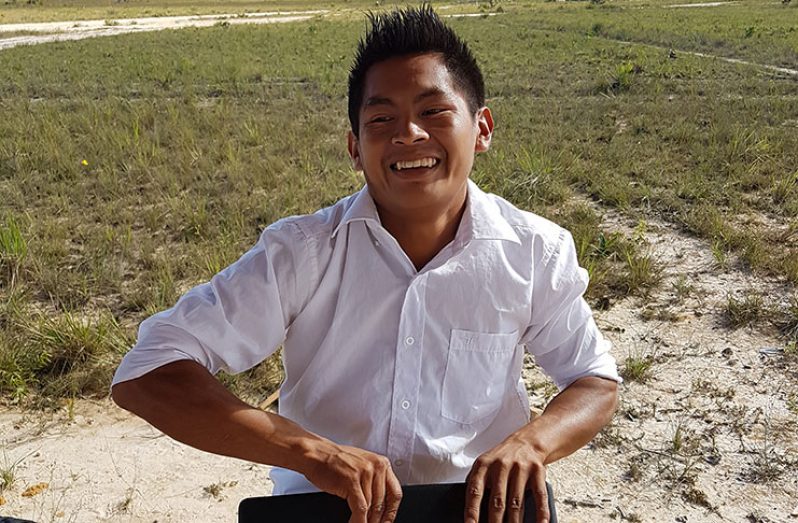By Ravena Gildharie
POLITICS, leadership and governance are often less sexy concepts for most young people of today’s society, and the majority shy away from such public roles. However, to those like 24-year-old Charles Lewis of Kanapang, it’s an opportunity to make a difference especially when you are the Village Leader of what is technically the “last village” of Guyana’s North Pakaraimas region which borders Brazil in the state of Roraima.
Home to about 37 households totalling a population of approximately 180, Kanapang is located about 21 miles from Kato, a more popular and easily-accessible village in the mountainous Region Eight. Kanapang is mostly farming-based though some residents work in the logging and mining industries outside of their area, according to Charles.
Because of its distance from other more-accessible communities of that part of the country’s hinterland, most residents rely on basic social services, such as health and education from across the border. It is believed that some residents even feel more connected to the South American neighbour than to their homeland.
At age 24, Lewis is the fifth of 11 children born to a family that has distinguished themselves as one of the earliest settlers in Kanapang. Charles is one of the few children from his community that completed secondary education. He attended Paramakatoi Secondary which is situated miles away from his home and secured several passes at the Caribbean Secondary Education Certificate (CSEC) examinations. Charles graduated as the top CSEC student in Region Eight, an achievement that earned him great honour in his village. He later taught for two years as a volunteer teacher and had plans to pursue studies of becoming a medic before he took up the leadership post.
All through secondary school, Charles maintained a keen interest in his village’s governance and actively participated in communal events, gradually gaining increased admiration and respect of his villagers. Just after finishing secondary school, he was elected as a councillor and later as Toshao in 2015, when he was just 22 years old. So what does it mean to be one of the youngest Indigenous village leaders?
“It is very challenging,” Charles chuckled in his reply, adding: “But it is a responsibility that the people believe I can fulfill, so I try my best to meet their expectations.” Though he evaluates support and cooperation of villagers at about 75 percent of the 180-odd population, the young leader believes it is enough to motivate his work and goals. And, though a few of the older residents sometimes disagree with some of Charles’ decisions, they don’t oppose his actions.

“Whenever we have community events, there are some people who don’t support or turn up but that is okay because I know there are others who will turn out,” Charles stated. His current term as Toshao runs until 2018 and Charles is determined to administer as much needed change as he possibly can, especially in the areas of health and education. Most children in the area attend school across the border where the Brazilian government provides transportation, meals and even financial support for the family of each pupil. Currently, there are about 25 children of Kanapang attending school in Brazil. The village’s school is taught by three teachers, all untrained.
Healthcare and other facilities
Though there is a health centre in Kanapang, only minor illness are treated there and residents are forced to seek advanced medical service in Brazil which sometimes require travelling by All Terrain Vehicles (ATVs) for between three to eight hours.
These are challenges that Charles would like to help address in his community to ensure the younger and upcoming generation enjoy a better way of life. In the area of health, the Toshao hopes to have a proficient medical doctor with adequate modern facilities to treat major illness suffered by residents and provide them with adequate supplies of necessary medications. Charles’ dream is also to have more trained teachers and perhaps in later years, even a secondary school in Kanapang.
Over the last two years, Charles and his village council have been busy establishing rules and regulations to govern the community as it relates to local governance, law enforcement and management of natural resources, while exploring opportunities to boost the socio-economic livelihoods of residents. According to Charles, most residents are subsistence farmers and others depend solely on the financial support they receive for their children enrolled in the Brazilian school.
Through the eyes of the young Toshao, it’s a quiet way of life in Kanapang, a village where Indigenous Guyanese of the Makushi and Patamona tribes learn Portuguese, as one of their first languages.
On the softer side, when not attending to his Toshao duties, Charles and some of his younger brothers are found performing in their own local band at weddings,birthdays and other social events.
He remains vocal and a vibrant young voice to represent the rights of Guyana’s first people.




.png)










1 thought on “The Young ToshaoL: Life in the Kanapang village”
keep it up charles lewis……